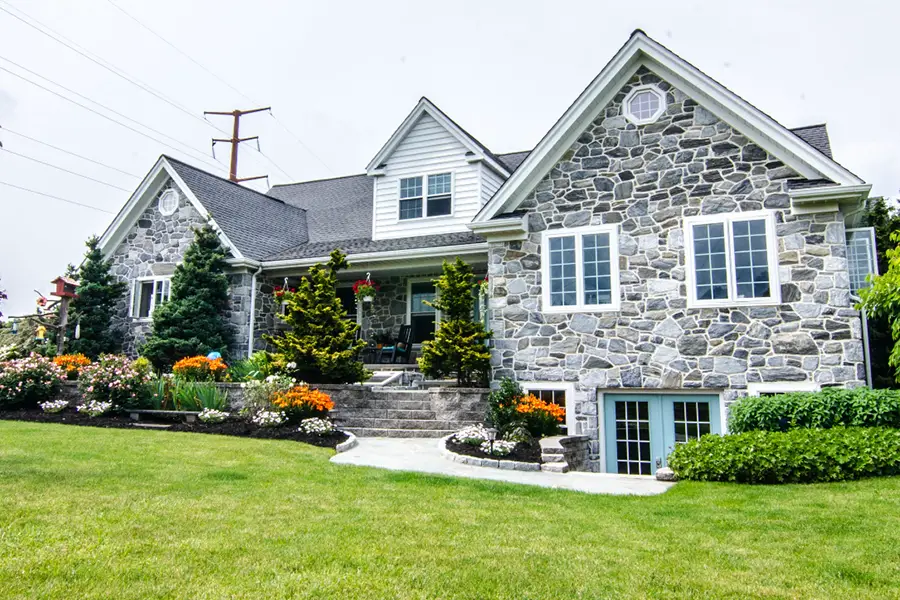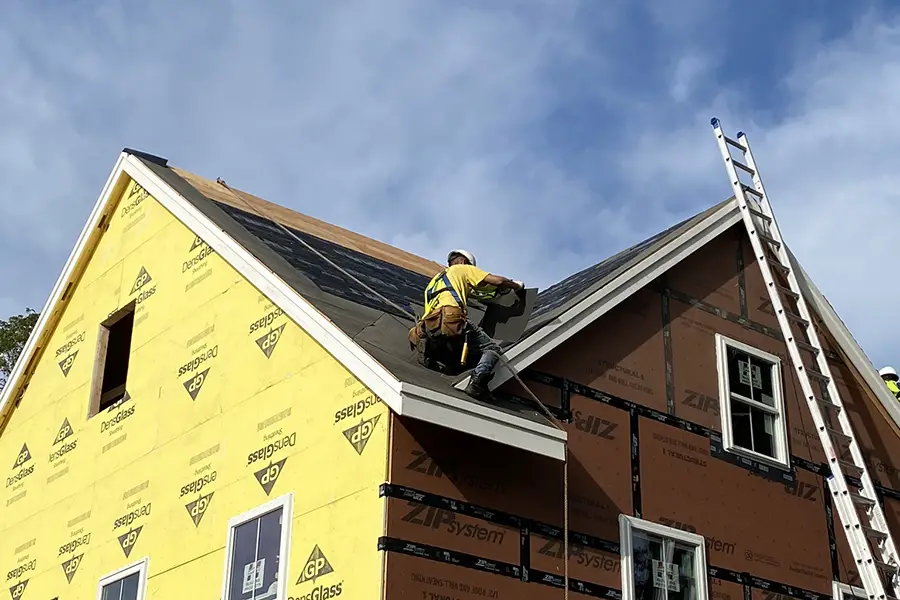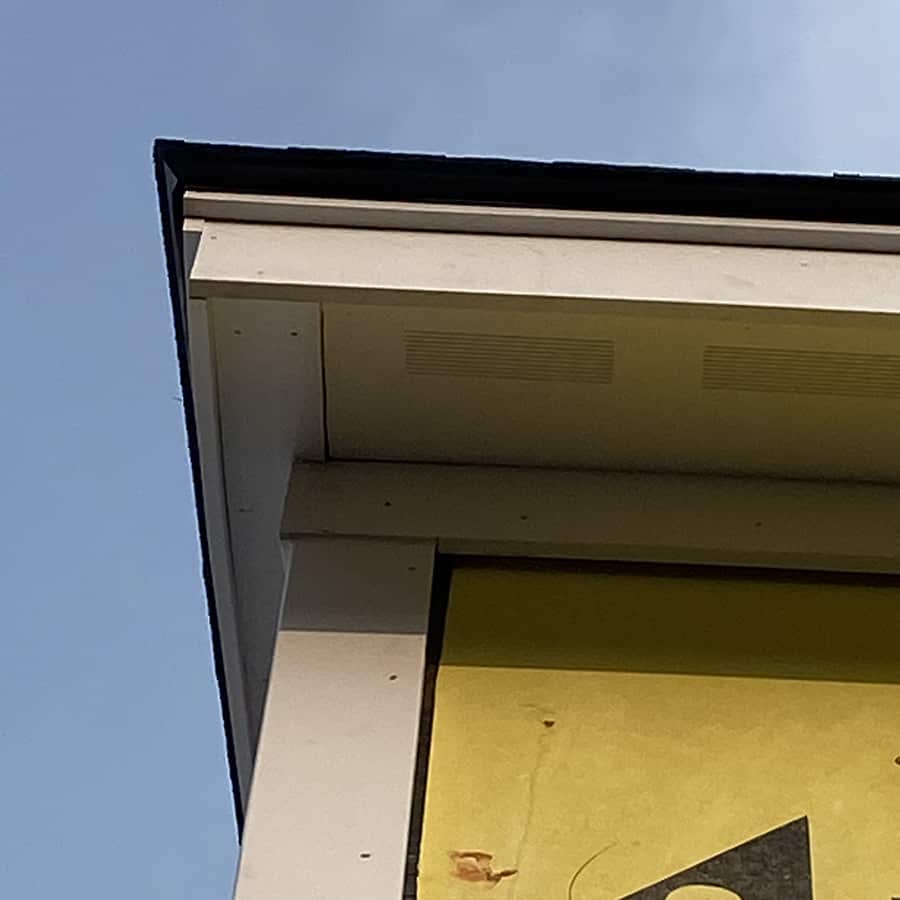If you’re like most homeowners, you take to the internet to do research before making any major changes or upgrades to your property. You might be re-roofing or re-siding your home and updating your roof soffits in the process. But what should you replace your soffit with? When it comes to soffits, there are several options available for consideration. They each have their reasons for being on the list, and today we’re breaking them down.
What is a soffit?
While there are some interior features also referred to as a soffit, for the purposes of this article, a soffit is the exterior underside of the overhang of your roof. Not all homes have one – but go outside and look up: if you have a roof whose eaves or rakes extend past your exterior walls, you have a soffit.
The soffit is the material used to enclose the space under and between the roof joists and extends horizontally between your siding and the edge of your roof fascia or your gutters. The main purpose of a soffit is to keep the elements out of the attic, roof, and wall construction while (often) providing passive ventilation to the attic.
Most soffit materials come with the option of being solid or vented. These vents help keep your attic air circulating and reduce the risk of moisture or mold build-up as well as protect against ice damns in colder climates. However, for aesthetic reasons or if your attic already has sufficient ventilation installed, your home may not require additional soffit ventilation.

What materials are soffits made from?
- Aluminum – A popular soffit material, aluminum is highly durable, lightweight, and easy to handle. It’s malleable and good for irregular shapes while installing. It requires regular but easy maintenance and cleaning- just hit it with your garden hose from time to time. It won’t rot, is pest and fire-resistant, and is less likely than steel to rust as it ages. However, the paint may chip over time, and need touching up or repainting.

- Wood/Timber – Wood is a very attractive and sleek soffit material that lends itself to both modern and traditional exterior styles. It’s paintable and easily customizable but ultimately will decay as it ages. Most wood soffits will require scraping, treating, and repainting at least once in their lifetime, if not more. It’s not very fire resistant, is susceptible to pests, and these days can be quite expensive or require a long wait. However, it’s probably the most common soffit material for single-family houses, it’s easy to work with, and it sure looks great! Below is a premium cedar soffit with wooden soffit vents, but many homes utilize a painted plywood soffit.
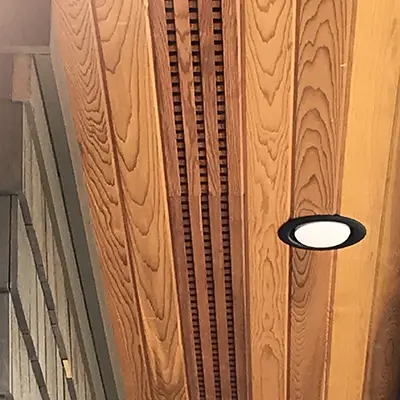
- Steel – A common option for decades, steel as a soffit material is well regarded for its durability and longevity. It is an efficient fire block and offers many colors and finish options. However, steel is expensive, and the surface may rust or its paint may become chalky over time. It’s also heavy and can require special equipment to cut and shape. Steel is also not the best insulator, and may not be the best material to be paired with interior attic insulation.
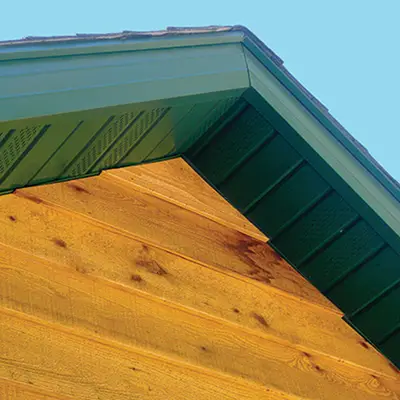
- Vinyl – Another popular modern option, vinyl is durable and virtually maintenance-free. Vinyl needs no refinishing, is affordable, and is not susceptible to damage from moisture or pests. However, vinyl can eventually be weakened by the sun and is certainly less fire-resistant than metal.
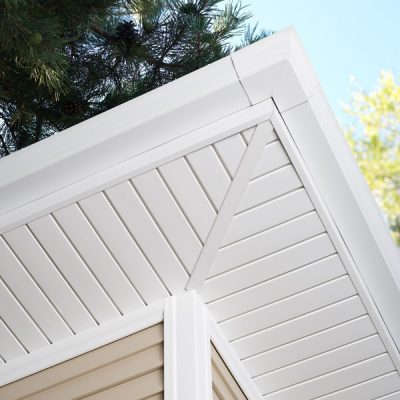
- Fiber Cement – Pricey, but also high value. Fiber cement is made up of sand, portland cement, silica, and cellulose fiber. Therefore, the manufacturing process for fiber cement is greener than, say, vinyl. It’s naturally water, fire, and pest resistant, and will not chip or peel after prolonged exposure to the elements. It offers stylish finishes with long life and minimal maintenance.

- PVC – Unplasticized polyvinyl chloride is a highly durable and affordable soffit material option. UPVC offers excellent paint adhesion and is stain resistant. It is a good insulator, better than its metal counterparts, and won’t peel, flake, rot, or warp over time, making it a good option for extreme climates.
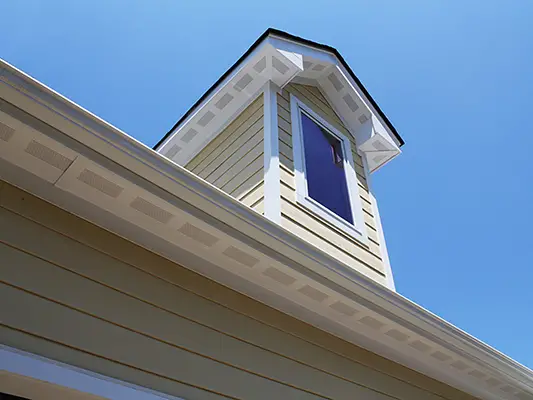
Cost considerations
Costs are changing rapidly right now and inventory across all industries is proving unpredictable. Budget a little more for this project than you think you need to for potential unexpected snafus and take the time to get multiple quotes once you’ve settled on a material.
Keep in mind that bigger chains may have different suppliers or supply chains than local retailers, and websites aren’t always up to date or accurate about delivery expectations. So don’t just accept the first answer! If multiple suppliers have what you’re looking for, see if you can leverage that for a discount or price match.
Consider whether to do the work yourself vs. hiring a professional. Contractors can help with or take over material sourcing (depending on the contractor), measuring, and ordering, and will typically include removal of older soffit (if this is a replacement job). They will overall be more efficient at the installation if you are in a time crunch, and will guarantee their work to an extent should an issue arise. Also, consider reaching out in late fall or early winter if your area allows, as you may get a discount for ordering in the down season!
While hiring someone else always increases overall project cost, also consider your confidence with the task and your chosen material. Do you have the skills to properly measure, cut, and fasten the material, likely on a ladder? If so, make sure you follow the manufacturer’s specifications. After all, avoiding a costly mistake in the first place is certainly the most financially responsible choice!
General maintenance
The material of your soffit will ultimately dictate specific maintenance needs, but here are some universal tips to keep in mind:
- Keep your soffit well-sealed and caulked. Especially if your area experiences an extreme storm or geological event! Go through and double-check that everything is still secure and sealed. (You’ll likely be doing this on your whole house in such an event, but don’t forget the soffit!)
- Check periodically for bee, hornet, and wasp nests.
- Remove any mildew regularly with a soft brush and bleach solution or eco-friendly soap. (If your soffit is above a garden, it won’t do to drip bleach into your plants!)
So, what soffit material is best?
Different materials are better suited for different applications, home styles, and budgets. Take notice of other homes in your area. What seems to be most common for your climate or architectural style? Do you want to stand out from the crowd with a color-popping statement, or blend in with something that simply serves its purpose? If you’re replacing fascias and trim, you probably want your soffit to be the same material as they can often be purchased as a system or assembly.
Perhaps your home is three stories, so a material like wood that requires more diligent maintenance isn’t the best fit. Maybe the area of your single-level home that has a soffit is relatively small and narrow, so you’d rather do it yourself and save some money for a different project.
Whatever your situation is, weigh your options carefully and make an educated decision. Let us know in the comments below which you think is best, and why!

